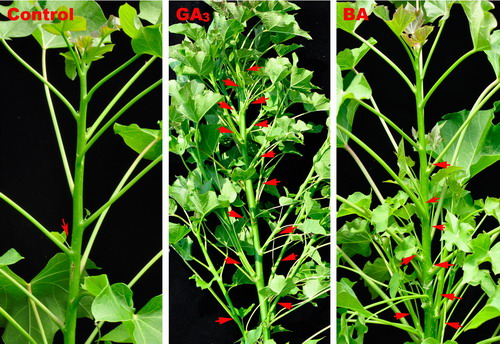Strigolactone (SL), auxin, and cytokinin (CK) were three key phytohormones that coordinately regulate shoot branching. Gibberellins (GAs) are a group of key hormones regulating many aspects of plant growth and development. In pea and Arabidopsis, CK is the only phytohormone playing a positive role in regulating bud outgrowth, while GA seems to inhibit this process. Intensive research has focused on identifying and characterizing the phytohormones that control lateral bud outgrowth. How plants flexibly optimize their architecture to adapt to the changing environment through manipulation of their endogenous phytohormone balance remains largely unknown.
Prof. XU Zengfu and his team of Xishuangbanna Tropical Botanical Garden (XTBG) conducted a study to see whether gibberellin (GA) is an active a positive regulator of shoot branching in the woody plant Jatropha curcas, a promising biofuel feedstock. They also investigated the interactions between GA and CK in the control of lateral bud outgrowth.
The researchers found that lateral branch outgrowth could be efficiently stimulated by treatment with the synthetic cytokinin (GA3), 6-benzyladenine (BA), in two-year-old J. curcas trees. Interestingly, GA3 was more effective at promoting shoot branching. They then found that dormant axillary buds located on old stems could still be activated by GA3 or BA treatment. They further generated transgenic J. curcas overexpressing a GA biosynthesis gene, JcGA20ox1. The grafted JcGA20ox1 transgenic plants showed accelerated growth and stem elongation, and enhanced lateral bud outgrowth. All the results supported the finding that GA promoted lateral bud outgrowth.
The researchers then evaluated the synergistic effect of these two hormones on the outgrowth of axillary buds in seedlings. The results showed that GA and CK synergistically regulated lateral bud outgrowth in J. curcas. Moreover, GA3, but not BA, induced lateral bud outgrowth on the newly developed shoots. The promotion of lateral bud outgrowth by GA3, BA, and decapitation treatment may be due to the inhibition of the expression of JcBRC1 and JcBRC2. They further found that bud outgrowth promoted by GA or CK was inhibited by strigolactone.
The study showed that GA acted as a positive regulator of shoot branching in the woody J. curcas. It also provided physiological and molecular evidences that GA interacted with two other well-studied phytohormones, CK and SL, in the control of lateral bud outgrowth in J. curcas.

Jatropha curcas (Image by NI Jun)

